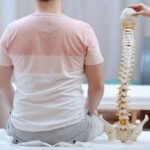According to Healthline, the temporomandibular joint (TMJ Pain) is the joint that connects your mandible (lower jaw) to your skull. The joints are located on both sides of your head in front of your ears. It allows your jaw to open and close, enabling you to speak and eat.
This abbreviation also refers to a group of health problems related to your jaw, but this is becoming more commonly abbreviated as TMD or TMJD to distinguish the temporomandibular joint itself from TMJ Pain. These disorders can cause tenderness at the joint, facial pain, and difficulty moving the joint.
The National Institute of Dental and Craniofacial Research said, as many as 10 million Americans suffer from TMJ Pain. TMJD is more common among women than men. These disorders are treatable, but there are many different possible causes. This can make diagnosis difficult.
Researchers generally agree that the conditions fall into three main categories:
- Myofascial pain involves discomfort or pain in the muscles that control jaw function.
- Internal derangement of the joint involves a displaced disc, dislocated jaw, or injury to the condyle.
- Arthritis refers to a group of degenerative/inflammatory joint disorders that can affect the temporomandibular joint.
A person may have one or more of these conditions at the same time.
Symptoms of TMJ Pain
TMJ Pain symptoms will vary for everyone. Some may have mild, annoying symptoms, while others can experience extreme and chronic pain. Symptoms of TMJ Pain can include headaches, jaw pain, clicking or pain when moving the jaw, such as when chewing food or talking neck pain, and even dizziness.
Because TMJ is more common in women than in men, scientists are exploring a possible link between female hormones and TMJ disorders.
If not dealt with, TMJ Pain can become increasingly more painful. Some may experience chronic jaw pain. While medication for pain may bring temporary relief, once the medication wears off, symptoms will return, sometimes even worse than before. Chiropractic care, however, is a long-term solution for TMJ relief. It gets to the root of the problem to bring about relief once and for all.
TMJ Pain Treatment
Because more studies are needed on the safety and effectiveness of most treatments for jaw joint and muscle disorders, experts strongly recommend using the most conservative, reversible treatments possible. Conventional treatments do not invade the tissues of the face, jaw, or joint, or involve surgery. Reversible treatments do not cause permanent changes in the structure or position of the jaw or teeth. Even when TMJ Pain have become persistent, most patients still do not need aggressive types of treatment.
Conservative Treatments
Because the most common jaw joint and muscle problems are temporary and do not get worse, simple treatment may be all that is necessary to relieve discomfort. Short term use of over-the-counter pain medicines or nonsteroidal anti-inflammatory drugs (NSAIDs), such as ibuprofen; the use of a stabilization splint, or bite guard, that fits over upper or lower teeth may provide relief. If they recommend a stabilization splint, it should be only for a short time and should not cause permanent changes in the bite. Studies of their effectiveness in providing pain relief have been inconclusive.
Irreversible Treatments
Surgical treatments are controversial, often irreversible, and we should avoid where possible. There have been no long-term clinical trials to study the safety and effectiveness of surgical treatments for TMJ Pain. Additionally, surgical replacement of jaw joints with artificial implants may cause severe pain and permanent jaw damage. Some of these devices may fail to function properly or may break apart in the jaw over time.
Helpful Tips
Self-care practices that may help ease symptoms of TMJ:
- eating soft foods,
- applying an ice pack,
- avoiding extreme jaw movements like wide yawning, loud singing, and gum chewing,
- learning techniques to relax and reduce stress,
- practising gentle jaw stretching and relaxing exercises that may help increase jaw movement.
Exercises for TMJ pain relief
Here are some exercises that we recommend if appropriate for your particular condition:
- Relaxed jaw exercise
- Goldfish exercises (partial opening)
- Goldfish exercises (full opening)
- Chin tucks
- Resisted opening of the mouth
- Resisted closing of the mouth
- Tongue up
- Side-to-side jaw movement
- Forward jaw movement
Can A TMJ Pain Eased by Chiropractic?
TMD is a general term that covers temporomandibular joint dysfunction, facial pain around the jaw joint and muscle problems that affect the joint’s movement. The condition has a range of causes, according to the Mayo Clinic, including jaw injury, poor teeth alignment and arthritis, as well as tension or stress — and sometimes the cause isn’t known. Consequently, when dentists or dental specialists treat TMD, they may prescribe several approaches.
Chiropractors realign bones and muscles to improve function and reduce pain in their patients, and they must pass an exam to receive a license to practice. A chiropractor can realign the bones of the neck to improve problems with the jaw joint.
As TMJ Hope explains, chiropractor gently adjusts the highest bones in the neck with a percussion instrument to reduce nerve interference that could be causing TMD. Other chiropractors who can treat TMD are those trained and has experience in treating TMJ Pain before. Most chiropractors also received TMJ relief training. These chiropractors also focus their treatment on repositioning the bones that connect the neck to the head.
Patients may need to visit a TMJ Pain chiropractor several times or even regularly in order to manage their TMD symptoms.
The Ins and Outs of Chiropractic Care for TMJ Pain
Because the jaw is a joint, West Texas Chiropractic Center can perform an adjustment on the jaw to relieve tension. Releasing the muscles surrounding the jaw can correct TMJ Pain so that the jaw can function normally once again.
But sometimes the problem doesn’t just lie within the jaw. Dysfunction of the spine caused by spinal misalignments can also cause tension within the body, including the jaw joint. Gentle chiropractic adjustments can remove misalignments to reduce nerve interference and tension and alleviate pain associated with TMJ Pain. Continual chiropractic care is often needed to ensure that problems don’t return. With regular chiropractic care, you can experience not only relief from TMJ Pain but also improved overall health and wellness because the benefits of chiropractic care are numerous.
About West Texas Chiropractic Center
At West Texas Chiropractic Center, every chiropractic treatment is designed specifically for each patient. Our team of qualified experts will work with you to address your unique needs and determine the appropriate treatment to mitigate your pain. You’ll find comprehensive treatment options whether you are experiencing back pain, neck pain, headaches, or even muscular tightness and tension from injuries. We are here to help diagnose and give effective treatment for problems with joint or muscle pain. If you’ve been looking for a qualified chiropractor who provides excellent treatments, look no further than West Texas Chiropractic Center!
Benefits Of Chiropractic Care And Treatment
Chiropractic care is an extremely safe and effective way to find relief for your pain while also improving your overall health and wellness at the same time. It is not just a treatment for body injuries; it’s changing your quality of life. It’s a way to gain better mobility and sleep, to improve your nervous and immune systems, and to enhance every function in your body.
Chiropractic care is primarily a pain relief alternative for muscles, joints, bones, and connective tissue, such as cartilage, ligaments, and tendons. It is sometimes in conjunction with conventional medical treatment. It aims to reduce pain and improve mechanical function or the way a person moves.
Chiropractic treatment is a safe, specific, controlled force applied to a joint to restore proper function and mobility. The pressure is applied to a person’s spine or other parts of their body by a qualified chiropractic doctor, or chiropractor, to do a chiropractic treatment. This pressure allows a chiropractor to adjust and correct alignment.
Chiropractic treatment is sometimes called spinal manipulation. Chiropractors use hands-on spinal manipulation and other alternative therapies. The theory is that proper alignment of the body’s musculoskeletal structure, particularly the spine, will enable the body to heal itself without surgery or medication.








